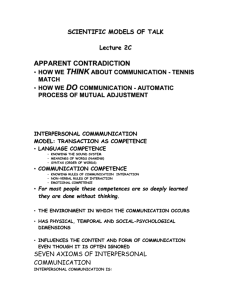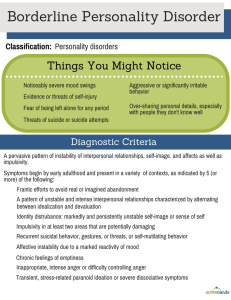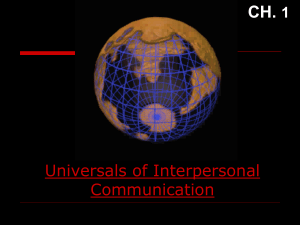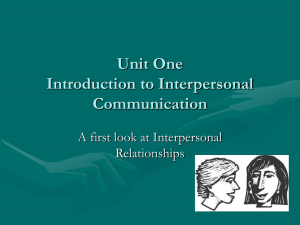interpersonal communication is
advertisement
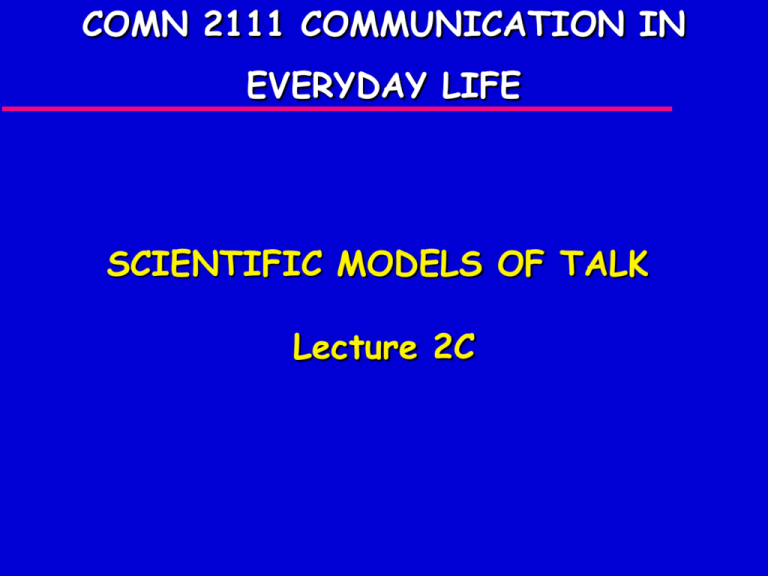
COMN 2111 COMMUNICATION IN EVERYDAY LIFE SCIENTIFIC MODELS OF TALK Lecture 2C SELF-FEEDBACK LOOP ( THE 2 PERSON RELATIONSHIP MODEL) SENDER MESSAGE RECEIVER CHANNEL S’s Self-image R’s Self-Image S’s Image of R S’s Projected Self-image R’s Projected self-image R’s Image of S APPARENT CONTRADICTION • HOW WE THINK ABOUT COMMUNICATION - TENNIS MATCH • HOW WE DO COMMUNICATION - AUTOMATIC PROCESS OF MUTUAL ADJUSTMENT COMMUNICATION AS AUTOMATIC TRANSACTIONS: THE PROCESS COMMUNICATION AS AUTOMATIC TRANSACTIONS: IN CONTEXT INTERPERSONAL COMMMUNICATION MODEL: TRANSACTION AS COMPETENCE • LANGUAGE COMPETENCE • KNOWING THE SOUND SYSTEM • MEANINGS OF WORDS (NAMING) • SYNTAX (ORDER OF WORDS) • COMMUNICATION COMPETENCE • KNOWING RULES OF COMMUNICATION INTERACTION • NON-VERBAL RULES OF INTERACTION • EMOTIONAL COMPETENCE • For most people these competences are so deeply learned they are done without thinking. THE CONTEXT • THE ENVIRONMENT IN WHICH THE COMMUNICATION OCCURS • HAS PHYSICAL, TEMPORAL AND SOCIAL- PSYCHOLOGICAL DIMENSIONS • INFLUENCES THE CONTENT AND FORM OF COMMUNICATION EVEN THOUGH IT IS OFTEN IGNORED SEVEN AXIOMS OF INTERPERSONAL COMMUNICATION INTERPERSONAL COMMUNICATION IS: 1. IP communication is inevitable, irreversible and unrepeatable 2. IP communication is a process of on-going adjustment over time. • IP communication is a system of interconnected elements that flare part of a dynamically inter-connective flow (axiom one). We constantly adjust our to each other as we talk. 3. Always contains relationship and content dimensions. • • The simultaneous exchanges of “mixed messages” - about the topic of the talk and us as people. Using “mixed meda” - words and non-verbals. SEVEN AXIOMS OF INTERPERSONAL COMMUNICATION INTERPERSONAL COMMUNICATION IS: 4. Complementary or symmetrical in effect • They reflect the exercise of power in the moment or in the on-going relationship, since one person’s behavior may stimulate either symmetrical (equally powerful) or complementary (different levels of power) responses from another. 5. Is always seen by each participant as a “series of punctuated events.” • We organize the seamless flow of an exchange into orderly sequences that support our view of ourselves, and the world. 6. IP Communication is a transactional process • A process of exchanging bits of our sevles while we are exchanging information about some topic in a process with no clear beginning, endings or exact sameness from one time to the next. THE FIRST SIX AXIOMS ARE ABOUT PROCESS • • • HOW THE PROCESS OF IP COMMUNICATION WORKS IN A UNIVERSAL SENSE ALL OF THESE FACTORS OPERATE EVERY TIME WE TALK BUT WE DON’T SAY THE SAME THINGS IN EVERY SITUATION THE SEVENTH AXIOM IS ABOUT PRAGMATICS THE PRAGMATICS OF COMMUNICATION • • • • • The effects of communication on others The reasons why we say what we do in particular situations PROBLEM SITUATIONS Two types (1) something that both parties recognize is “at arm’s length” from the conversation itself because they think they are communicating quite effectively in the situation, or (2) an issue about the talk itself – a “communication breakdown” – where one or both of the speakers feels misunderstood or unappreciated by the other. THE SEVENTH AXIOM 7. In interpersonal communication, when faced with difference, disagreement, or disorder, human beings need to be or feel right.
